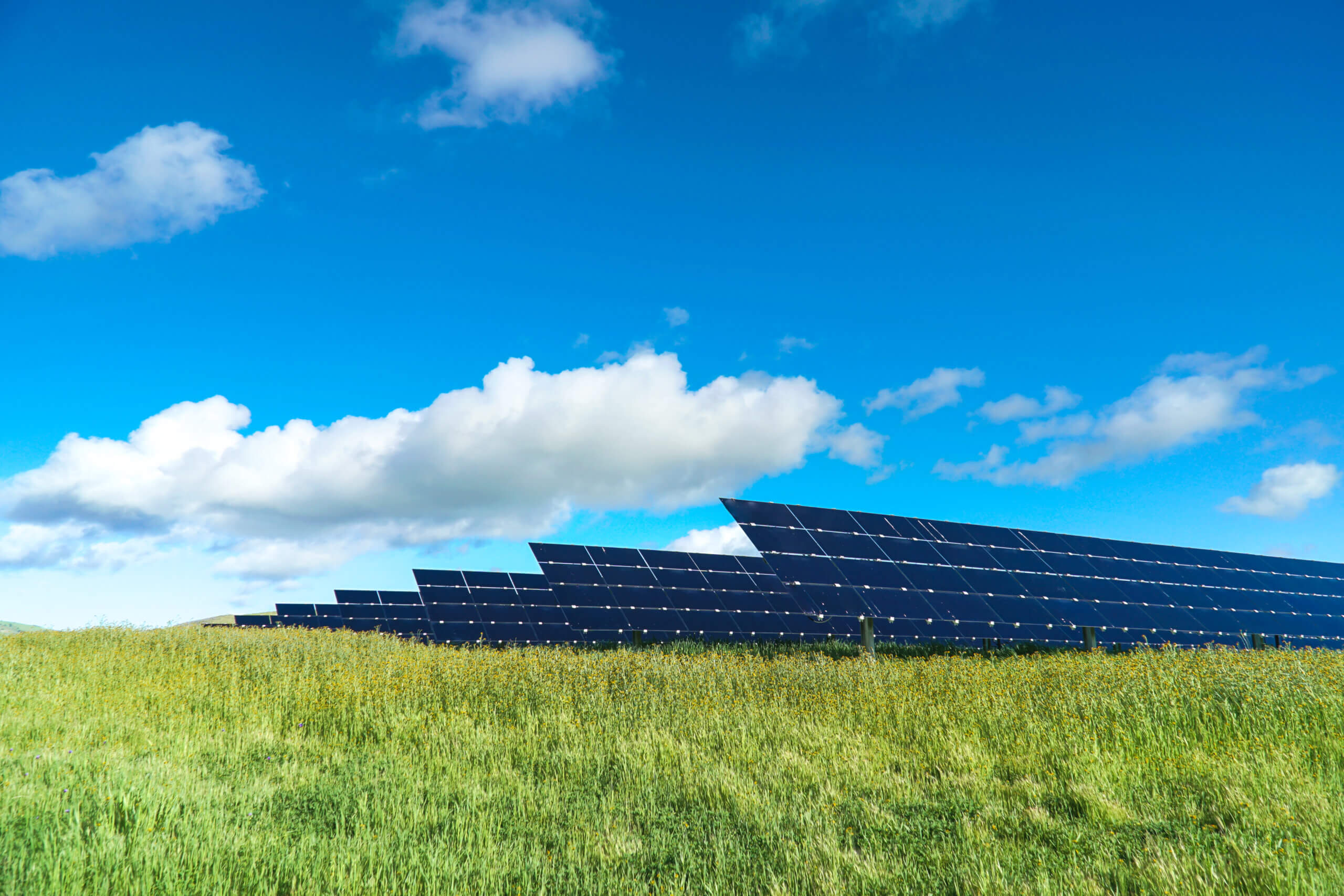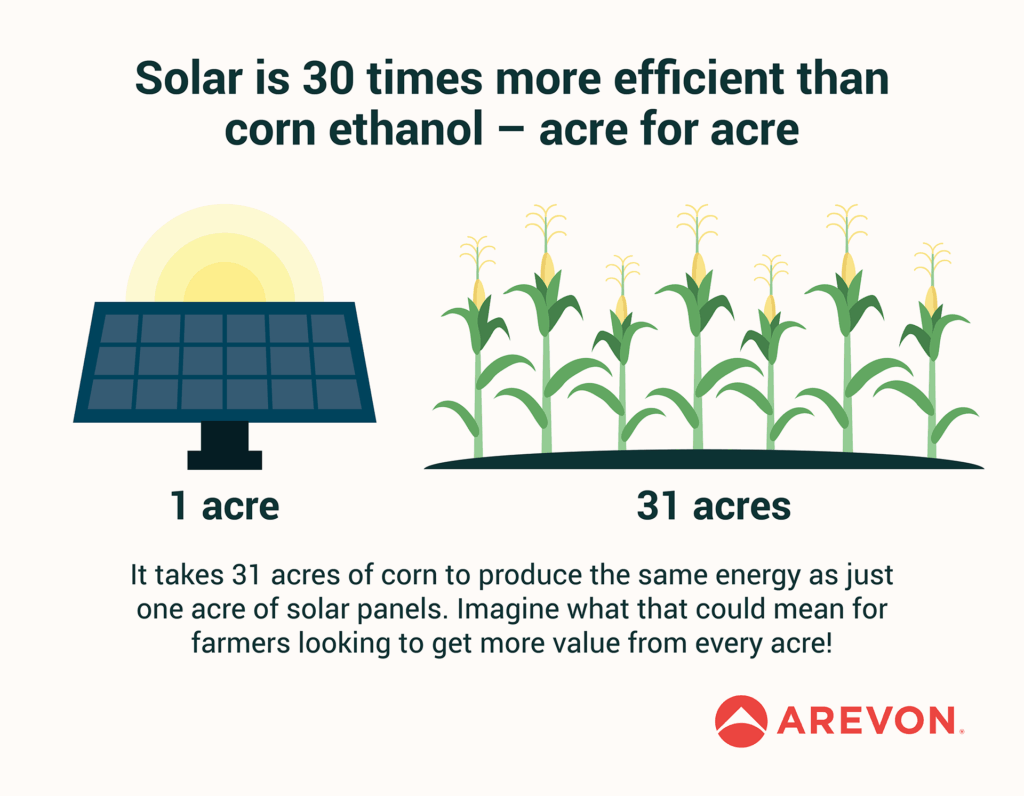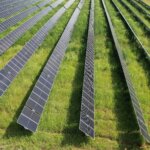May 29, 2025
Farmland is Already Used for Energy – Why Not Solar Too?
30 million acres of U.S. farmland already produce energy through ethanol. Like ethanol, solar is homegrown American energy — and gives farmers another tool to keep their land and livelihood strong.

Adding solar is an efficient way to produce energy on farmland — in addition to growing corn for ethanol, with over 40% of U.S. corn production used to produce ethanol. Solar energy offers farmers a powerful way to boost farm income, save resources, and strengthen rural America — all while strengthening the farming industry.
Millions of acres of American farmland are already being used to produce homegrown energy — through crops like corn grown for ethanol, but they represent just a few percent of the total farmland in the U.S. Now, new research from Cornell University shows that adding solar to farmland could deliver far more energy output per acre, using fewer resources, like water and fertilizers, and offering farmers a new way to strengthen their bottom line.
This isn’t about losing farming acreage. It’s about giving farmers another tool to stay strong — and another way to power America with energy produced right here at home.
Q&A: Solar, Corn Ethanol, and the Future of Farmland
Question: Why do communities support using farmland to grow corn for ethanol, but are sometimes unsure about solar panels?
Answer: It’s a fair question — and one worth taking a closer look at. Corn for ethanol and solar panels might look different, but they’re both doing the same thing: using farmland to produce American-made energy.
Ethanol has been an important part of our domestic energy mix, especially in rural communities. But new research from Cornell University shows that solar could be another strong addition — one that produces more energy per acre, brings in much greater income, and uses far less water and fertilizer. Here’s what the study found.
Homegrown Energy: Side by Side
Farmland is already a major source of energy today. 30 million acres of U.S. farmland are currently used to grow corn for ethanol — not food, but now a major part of America’s domestic biofuel supply and rural economy.
Solar delivers far more energy per acre. It takes 31 acres of corn grown for ethanol to produce the same energy as just one acre of solar panels. That’s a 30-to-1 difference — imagine what that means for farmers trying to get more value from every acre.

A small shift would make a big difference. If just 3.2% of current corn-for-ethanol farmland — the land already near electric lines — were converted to solar, it would produce the same amount of energy as all 30 million acres of corn.
Solar doesn’t need much land to make a big impact. According to the U.S. Department of Energy, meeting the goal for solar to provide 45% of the nation’s electricity by 2050 would require just 0.5% of the continental U.S. land area. Even if all of that were sited on farmland, it would use only about 1% of America’s agricultural land — far less than the nearly 4% currently used to grow corn for ethanol.

Fewer inputs, fewer costs. Using just a fraction of farmland for solar would reduce the use of millions of pounds of fertilizer and save billions of gallons of water annually — helping preserve natural resources for the long haul.
A reliable revenue stream. Leasing land for solar can earn farmers 3-4 times more per acre than traditional crops, including corn for ethanol — often with lower costs, less labor, and longer-term certainty. That kind of income stability can help keep family farms in family hands. Diversifying a farmer’s income with higher-priced solar leases can also support the entire operation — helping cover costs, ride out market swings, and preserve the farm for the next generation.
Doesn’t take food off the table. Both corn ethanol and solar are energy crops and both can coexist alongside traditional farming. In fact, solar can free up land and water to support food-growing operations elsewhere on the farm. It’s also worth noting that a significant portion of our U.S. crops aren’t needed to feed Americans — they’re exported. For example, up to 60% of soybeans and 20% of corn are shipped overseas. In some parts of the country, the U.S. government even pays farmers not to grow and allow ground to remain fallow in order to prevent oversupply or ease water shortage concerns.
Solar supports healthy soil and pollinators. The land under solar panels can be seeded with native grasses and wildflowers, helping reduce runoff, support pollinators, and improve soil health — all while continuing to produce cost-effective, reliable American energy. Where practicable, solar projects can also keep the land in agricultural production through practices like sheep grazing under and around the panels, allowing farmers to maintain agricultural use while generating new income.
Adding solar to a relatively small portion of existing farmland isn’t about losing farming acreage — it’s about giving farmers another way to stay strong and keep the entire farm productive for generations to come with an attractive diversified income stream.
This is Arevon
Follow us on LinkedIn for more stories of how we’re powering progress.

Author: Kevin Smith
Chief Executive Officer



